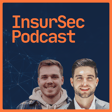
Steven Schwartz - The Cyber Steve
In Episode 3 of The InsurSec Podcast, we were joined by Steven Schwartz, aka "The Cyber Steve" aka "The Cyber Risk Quantification Stud" (my favorite), to explore the evolution of cyber insurance and the future of cyber underwriting. With over 15 years in the cyber ecosystem, Steve brings invaluable perspective.
He recounts his journey into insurance and the very early days of standalone cyber. We discuss the pros and cons of today's shotgun application process and the need for more standardization. Steve explains how true inside-out data can provide unparalleled risk insights versus outside-in scanning.
Steve breaks down how Safe Security is quantifying cyber risk through millions of security signals and turning bits into dollars. We examine the challenges of risk modeling and Steve offers a vision for the next generation of underwriting leveraging transparency, automation, and verified security frameworks.
Steve provides practical advice on incrementally improving cyber risk management and the incentives insurers can provide. With Safe, insurers can truly reward insureds for their investments in cybersecurity.
This was a conversation for the books.
Find Steve on LinkedIn or at steven.s@safe.security

